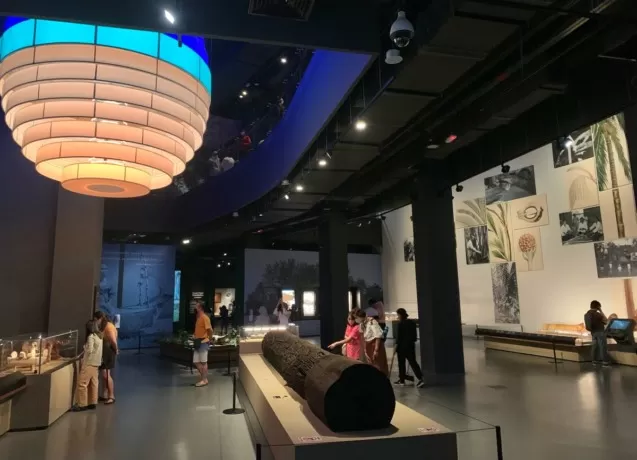Embrace Borneo's Heritage: Visit Cultures Museum
Embrace Borneo's Heritage: Visit Cultures Museum
Blog Article
Explore the Interesting Globe of Borneo's Cultural Heritage: A Comprehensive Overview to the Cultures Gallery Experience
Submersing oneself in the complex tapestry of Borneo's cultural heritage belongs to getting started on a voyage with time and custom. The blend of aboriginal people, standard handicrafts, fascinating efficiencies, and historical stories housed within the confines of the island's galleries uses a glance into a globe brimming with extensive legacies and vibrant custom-mades. As site visitors traverse through these databases of society, they are bid to discover a realm where past and present intermingle, inviting consideration on the durability and richness of Borneo's varied heritage.
Native People of Borneo
Borneo is home to over 50 aboriginal tribes, each with one-of-a-kind social practices and customs that have actually been maintained for generations. Among these tribes are the Iban, understood for their complex tattoos and traditional longhouses where numerous families live.
These native people play a crucial duty in keeping Borneo's rich social tapestry. Regardless of outside impacts and modernization, numerous people continue to promote their customizeds, ideas, and languages. Site visitors to Borneo have the possibility to involve themselves in the one-of-a-kind way of livings of these tribes with social trips, homestays, and community-based tourism campaigns. By engaging with these indigenous areas, visitors can obtain a much deeper admiration for the variety and durability of Borneo's aboriginal heritage.
Conventional Inventions and Artifacts

One famous example of traditional handicrafts in Borneo is the manufacturing of woven products - Borneo Cultures Museum. Competent weavers utilize all-natural fibers like bamboo, pandan, and rattan delegates produce intricate baskets, mats, and devices decorated with vivid patterns that hold symbolic meanings within the area
The art of woodcarving is an additional substantial aspect of Borneo's traditional inventions. Artisans carve elaborate designs into numerous kinds of wood to generate masks, sculptures, and musical instruments that not just offer functional functions however likewise hold social significance, commonly illustrating mythology or spiritual ideas.
In Addition, Borneo is renowned for its beadwork, with artisans thoroughly crafting grains from products like glass, seeds, and shells to develop precious jewelry, clothing embellishments, and decorative things that display the region's vibrant visual customs. These typical handicrafts and artefacts not just function as concrete expressions of Borneo's cultural heritage but also give insights right into the areas' beliefs, values, and way of life.

Social Performances and Festivals
With a deep-rooted connection to their cultural traditions, the neighborhoods in Borneo come alive via vibrant social performances and festivals that commemorate their heritage. These events display the rich diversity of Borneo's ethnic groups, each offering special dancings, songs, and rituals that have been given via generations. One of one of the most popular festivals is the Gawai Dayak, commemorated by the Dayak people to mark the rice collecting period. Throughout this festival, traditional songs fills the air, intricate dancings are done, and elaborate typical outfits are put on. An additional considerable occasion is the Pesta Kaamatan, celebrated by the Kadazandusun area to give many thanks for the rice harvest. This celebration includes cultural performances, consisting of the Sumazau dancing, and standard sports like the bamboo dancing. Site visitors visit to Borneo can description immerse themselves in these festivities, gaining a much deeper understanding of the region's social heritage and experiencing the warm hospitality of its people. Cultural efficiencies and festivals act as a vivid tip of Borneo's rich cultural tapestry and the significance of maintaining these practices for future generations.
Historic Narratives and Artefacts
Exploring the historical narratives and artifacts of Borneo supplies an interesting glance into the region's rich past and cultural evolution. Borneo's historical tapestry is woven with diverse impacts, mirroring the interactions in between native people, Chinese investors, European colonizers, and Malay sultanates. The artifacts located in Borneo showcase this detailed history, varying from conventional crafts like intricate beadwork and woodcarvings to archaeological prizes such as ancient pottery and devices.
One of one of the most engaging aspects of Borneo's historical stories is the preservation of oral traditions passed down via generations. These tales supply understandings right into the ideas, customizeds, and day-to-days live of Borneo's occupants throughout the centuries. The artifacts discovered from archaeological websites use substantial links to these stories, allowing visitors to witness the product culture of previous societies firsthand.
Contemporary Cultural Conservation Efforts

Moreover, curricula and social exchange tasks play a vital duty in increasing understanding about the value of protecting Borneo's special social heritage. By engaging institutions, museums, and the wider neighborhood in discussions and activities that celebrate Borneo's diverse cultures, preservation efforts can obtain energy and support for lasting sustainability. Partnerships between governmental bodies, non-profit companies, and regional communities are crucial in driving these conservation endeavors onward, ensuring that Borneo's rich social heritage stays vivid and valued next page for generations ahead.
Conclusion
To conclude, the social heritage of Borneo is diverse and abundant, with native people, standard handicrafts, social performances, festivals, historic narratives, and contemporary conservation initiatives all adding to its uniqueness and relevance. Visitors to Borneo's cultural museums can obtain a much deeper understanding and appreciation of the region's cultural heritage, enabling a much more immersive and informing experience.
Submersing oneself in the detailed tapestry of Borneo's social heritage is akin to getting started on a trip with time and custom.With a deep-rooted connection to their cultural practices, the neighborhoods in Borneo come alive via dynamic social efficiencies and events that commemorate their heritage. Cultural efficiencies and festivals serve as a vivid reminder of Borneo's abundant cultural tapestry and the significance of maintaining these customs for future generations.
Additionally, academic programs and social exchange activities play an essential function in raising awareness concerning the relevance of preserving Borneo's distinct social heritage. Partnerships between governmental bodies, charitable organizations, and neighborhood areas are crucial in driving these conservation ventures forward, making certain that Borneo's rich cultural heritage continues to be dynamic and treasured for generations to come.
Report this page